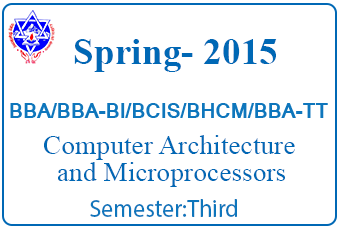
| Level: Bachelor | Semester –Spring | Year: 2015 |
| Program: BCIS | Full Marks: 100 | |
| Course: Computer Architecture and Microprocessor | Pass Marks: 45 | |
| Time: 3hrs. | ||
| Candidates are required to give their answers in their own words as far as practicable. |
| The figures in the margin indicate full marks. |
| Section “A”
Very Short Answer Questions Attempt all the questions. |
10×2 |
|
| 1. | What do you mean by microprocessor? | |
| 2. | What is the instruction format? Briefly Explain any one of them | |
| 3. | Why opcode fetch cycle uses 4-T states? | |
| 4. | What are registers? What is the function of the register in the microprocessor? | |
| 5. | What are the ways of address decoding and which one is more preferable? | |
| 6. | What is a PPI device? | |
| 7. | Define IVT and ISR briefly. | |
| 8. | What is parallel and concurrent System? | |
| 9. | What is ISA? | |
| 10. | Which type of architecture is better among RISC and CISC? Explain. | |
| Section “B”
Descriptive Answer Questions Attempt any six questions |
6×10 |
|
| 11. | Compare Von-Neumann and Harvard architecture with suitable diagrams. | |
| 12. | Define instruction set. Write a program in 8085 ALP to subtract from a number stored in location COOOH to COO1H if negative send to port address 01H otherwise OOH. | |
| 13. | Define PC Bus. Explain RS-232c Standard for serial communication. | |
| 14. | Draw and explain the timing diagram for MVIA, 32H. | |
| 15. | Explain the different modes of 8255A PPI device. | |
| 16. | Draw a block diagram of 8259 PIC and explain initialization command words (ICWS) and operational command words (OCWS) | |
| 17. | Differentiate between synchronous and asynchronous communication. Explain how two computers are connected via Null Modem connection. | |
|
18. |
Section “C” Case Analysis a) A set of 10 current readings is stored in memory locations starting at 1060H. The readings are expected to be positive(<127). Write a program to: i. Check each reading to determine, whether it is positive or negative. ii. Reject all negative readings. iii. Add all positive readings iv. Output FFH to port 1, at any time when the sum exceeds 8 bits to indicate overload; otherwise display the sum. b) Write an ALP to find the sum of the following type of operation:
|
2×10 |
You may also like: Computer Architecture and Microprocessor || Spring 2016

Leave a Reply